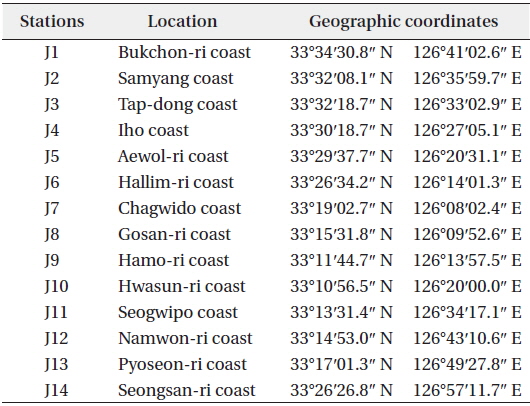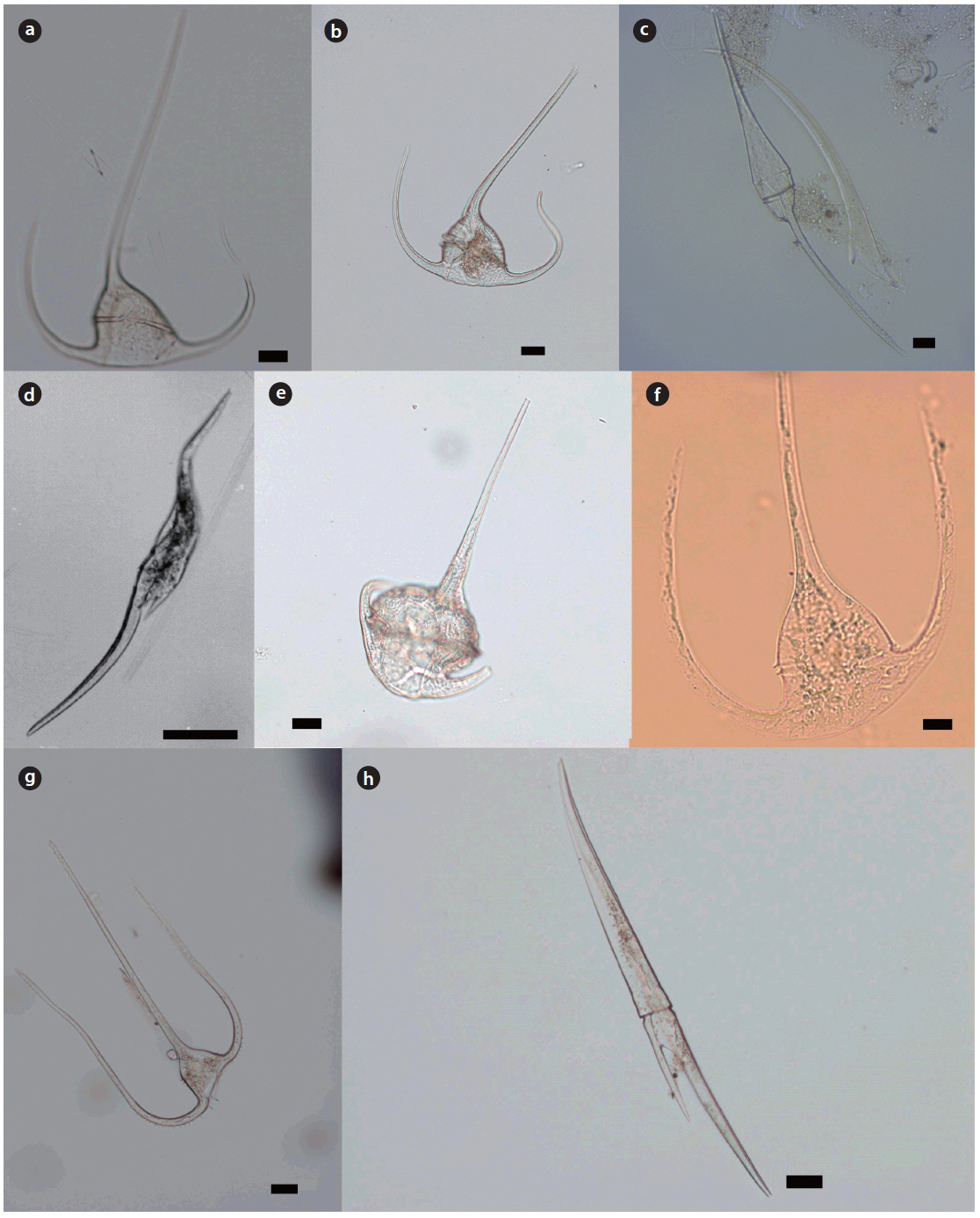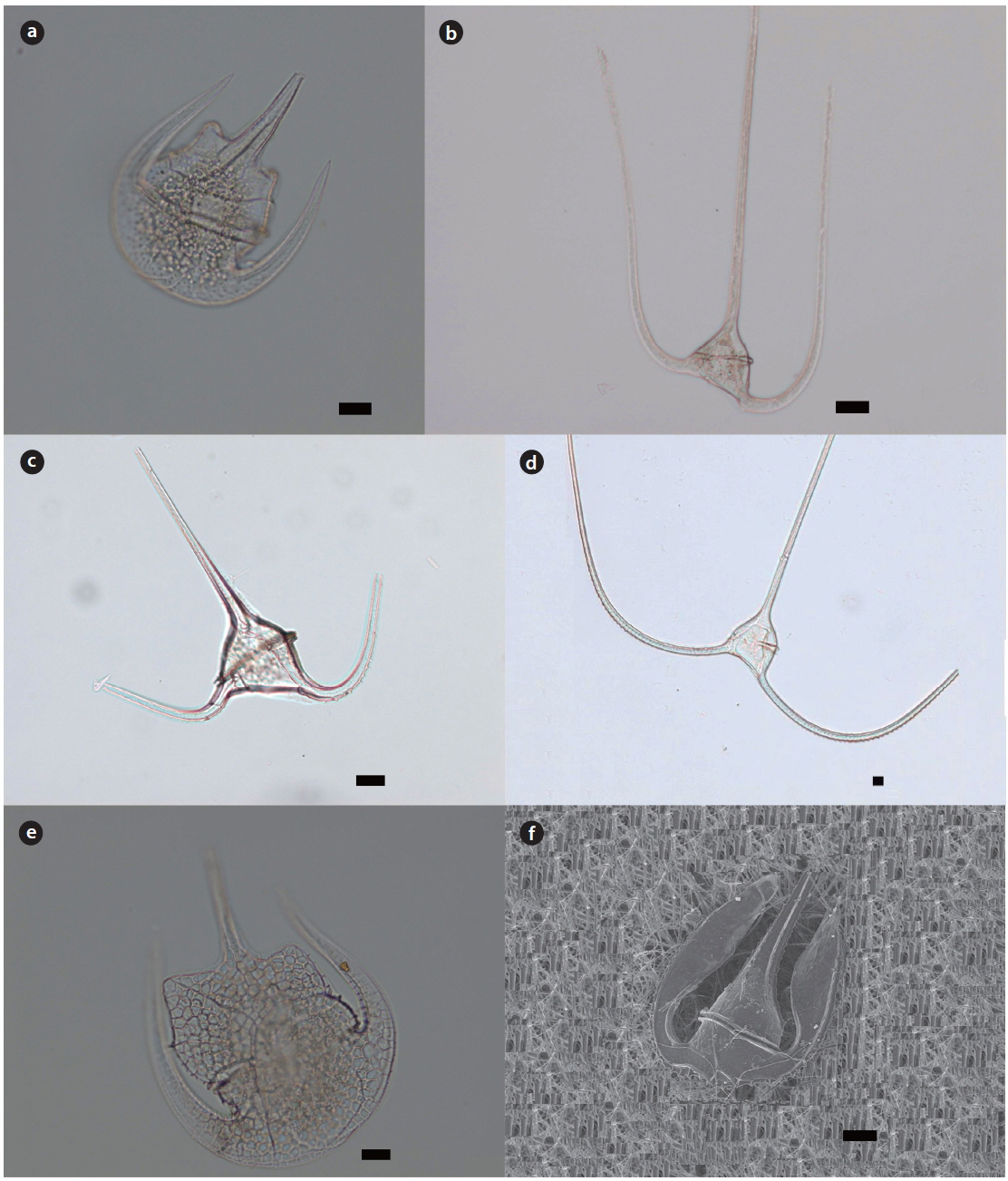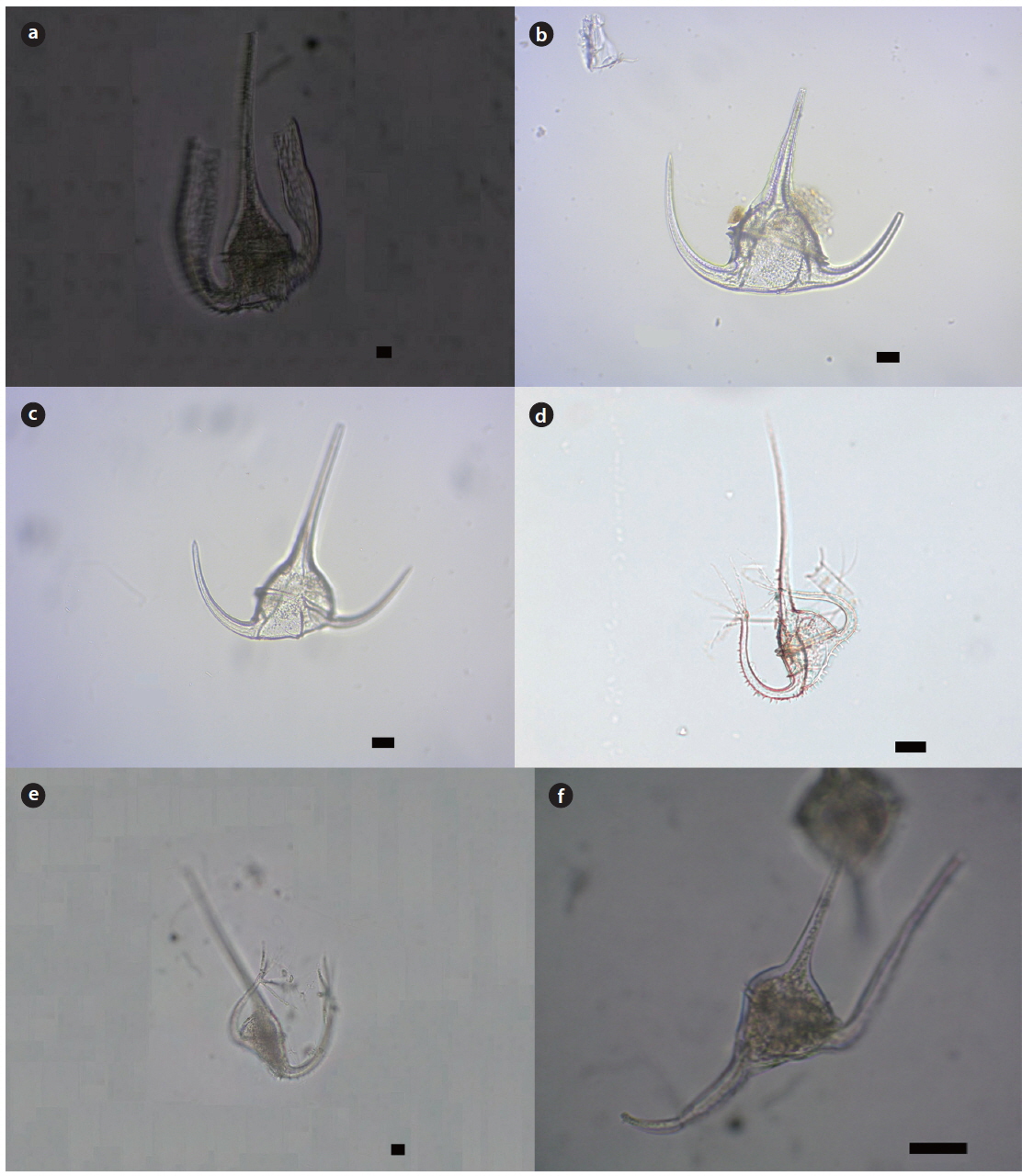



The morphology of 26 species of the genus Tripos was studied among a total of 51 species of this genus, which were taken using 20 μm net samples from June 2006 to January 2011 at 14 stations around Jeju Island. Of these, 23 species were first described as new records in Korean waters and 3 species were redescribed. Short descriptions and synonyms are given for each species in the present study. The dinoflagellates of family Ceratiaceae include marine and freshwater species, belonged to originally the genus Ceratium. Recently, this genus were divided into a new combination with the genus Tripos, which contains the marine species, and the original genus Ceratium, including the freshwater species. We used the Tripos genus for the marine species in this study as a valid name.
As one genus of Dinophyceae, the genus
Many marine species belonged to the genus
Samplings were done from 14 stations located around Jeju Island during the period from June 2006 to May 2011 (Table 1). Plankton samples were obtained using a 20 μm pore size plankton net and fixed with formaldehyde (final concentration of 0.4%) or glutaraldehyde (final concentration of about 1%). Planktonic dinoflagellates were identified using an Axioplan microscope (Carl Zeiss, Oberkochen, Germany). To make slide specimens for one species, the dinoflagellate samples were washed with distilled water, and then proceeded by the method described in Kim et al. (2013). For more detail observation, dinoflagellate cells were isolated with a micropipette, placed on a cover slip, air-dried, and coated with gold for observation with a Field Emission Scanning Electron microscope (JSM-6700F; JEOL, Tokyo, Japan). For identification, several monographs were used that were reported from different oceans, such as the Indian Ocean (Taylor 1976), the seas adjacent to Japan (Yamaji 1984: 97-158), the British and the Atlantic Ocean (Dodge 1982, 1985), the Kuroshio Current (Fujioka 1990) and Korean waters (Shim 1994: 349-419). For classification, the new combination with the genus
[Table 1.] Sampling stations around Jeju Island, Korea, June 2006 ? May 2011

Sampling stations around Jeju Island, Korea, June 2006 ? May 2011
A total of 51 species of the genus
>
Checklist of the genus Tripos occurred around Jeju Island
Class Dinophyceae G.S. West & Fritsch 1927
Order Gonyaulacales F.J.R. Taylor 1980
Family Ceratiaceae Kofoid 1907
Genus
*
**
*
*
*
*
*
*
*
*
**
*
*
*
*
*
*
*
*
*
*
*
**
*
*
*
>
Taxonomic description of unrecorded dinoflagellates
Genus Tripos Bory 1823 Tripos axialis (
Basionym:
Synonym:
References: Kofoid 1907, p. 170, pl. 4, fig. 26; Fujioka 1990, p. 51, pl. 25, fig. 3.
Specimen examined: NIBRFL0000125563 at the National Institute of Biological Resources (NIBR), Incheon.
Description: The antapical horn is asymmetrically curved, like a bow. The apical horn is fine and long, with 1.5–2 times the length of the body. The part that links the epithecal body and the apical horn is smoothly curved.
Size: Length 220–240 μm, width 50–60 μm.
Sampling: November 2009 in J7 (Chagwido coast, see Table 1 for the sign of sampling sites).
Tripos contortus (
Basionym:
Synonym:
References: Gourret 1883, T. 2, fig. 33; Yamaji 1984, p. 140, pl. 46, fig. 10; Shim 1994, p. 362, fig. 430; Okolodkov 2010, pl. 4, fig. 8, pl. 5, fig. 1, pl. 8, fig. 6, pl. 11, fig. 8, pl. 12, fig. 1.
Specimen examined: NIBRFL0000125588.
Description: The cell shape is long, with a quite long apical horn that is slightly curved. The antapical horns stretch in both directions, the right antapical horn is more curved in the middle part.
Size: Length 190–200 μm, width 50–60 μm.
Sampling: September 2010 in the southern sea of Jeju Island.
Tripos fusus var. schuettii (Lemmermann 1899)
Synonym:
Reference: Yamaji 1984, p. 139, pl. 45, fig. 5.
Specimen examined: NIBRFL0000125589; Unrecorded species no. LJB2013-04 at the National Institute of Biological Resources (NIBR), Incheon.
Description: The body shape seems similar to that of the
Size: Length 250–350 μm, width 30–40 μm.
Sampling: July 2010 in J7 (Chagwido coast).
Tripos geniculatus (Lemmermann 1899)
Basionym:
Synonym:
References: Karsten 1907, pl. 50, fig. 3a, b; Subrahmanyan 1968, p. 28, figs. 43-45; Fujioka 1990, p. 55, pl. 27, figs, 2a, b; Okolodkov 2010, pl. 1, fig. 3, pl. 10, fig. 2.
Specimen examined: Unrecorded species no. LJB2013-08.
Description: The cells are spindle-shaped and relatively long. The cell body is long and clearly constricted in the middle. The epitheca is inflated, its distal part suddenly draws into an apical horn, and the hypotheca tapers into a long left antapical horn that is slightly curved. The apical horn is positioned closer to the left side of the cell, and is notably deflected to the left at its base. A reduced right antapical horn is present. The widest point is adjacent to the cingulum and also to the front of the constriction in the middle of the cell body.
Size: Length 150–160 μm, width 10–20 μm.
Sampling: July 2010 in J7 (Chagwido coast).
Tripos gibberus f. sinistrus (
Basionym:
Synonym:
Reference: Yamaji 1984, p. 140, pl. 46, fig. 5.
Specimen examined: NIBRFL0000125591.
Description: The cell shape is slightly thick and flat. The apical horn is relatively stretched and the antapical horn is severely curved towards the dorsal side.
Size: Length 150–230 μm, width 100–130 μm.
Sampling: January 2011 in J14 (Seongsan-ri coast).
Tripos gracilis var. symmetricus (
Basionym:
Synonym:
Reference: Yamaji 1984, p. 145, pl. 47, fig. 13.
Specimen examined: NIBRFL0000125594.
Description: The cell is medium in size and slightly thin. The apical horn is slightly curved and upright, but both antapical horns have the same length and thickness. The girdle furrow is distinct and never converges.
Size: Length 100–130 μm, width 50–70 μm.
Sampling: January 2011 in J14 (Seongsan-ri coast).
Tripos incisus (G. Karsten 1906)
Basionym:
Synonym:
Reference: Karsten 1907, T. 23, fig. 6a, b; Fujioka 1990, p. 55, pl. 27, fig. 8.
Specimen examined: NIBRFL0000125565.
Description: The antapical horn stretches downward sharply. The left antapical horn is 2 times longer and 1.5 times thicker than right one. The apical horn is not distinguished.
Size: Length 260–280 μm, width 15–20 μm.
Sampling: January 2010 in J14 (Seongsan-ri coast).
Tripos lamellicornis (
Basionym:
Synonym:
Reference: Yamaji 1984, p. 146, pl. 48, fig. 8.
Specimen examined: Unrecorded species no. LJB2007-02.
Description: The antapical base is narrow and long, and stretched to the apical horn. The widest wing of the antapical horn is 2–2.5 times wider than the base part and is separate from the apical horn. The outside of the antapical horn has many gearwheel-like protuberances.
Size: Length 140–150 μm, width 48–54 μm.
Sampling: November 2006 in J7 (Chagwido coast).
Tripos limulus (C.H.G. Pouchet 1883)
Basionym:
Synonym:
References: Gourret 1883, p. 33, T. 1, fig. 7; Fujioka 1990, p. 57, pl. 28, fig. 1; Okolodkov 2010, pl. 4, fig. 3, pl. 11, fig. 4.
Specimen examined: NIBRFL0000125566.
Description: The apical horn length is relatively short, and there are protruding horns from both sides of the epitheca. The antapical horn is thick and stretches out and upward.
Size: Length 160–170 μm, width 80–90 μm.
Sampling: January 2010 in J14 (Seongsan-ri coast).
Tripos longissimus (
Basionym:
Synonym:
Reference: Schröder 1900, p. 16, T. 1, fig. 171; Wood 1963, p. 298, fig. 228.
Specimen examined: NIBRFL0000125564.
Description: Both sides of the antapical horn stretch upward with almost equal length, and the apical horn also has a straight, upright line. The bodies of the epitheca and the hypotheca are slightly small, but the whole body is bigger than the normal middle size of the genus
Size: Length 200–210 μm, width 30–40 μm.
Sampling: January 2010 in J7 (Chagwido coast).
Tripos macroceros var. gallicus (
Basionym:
Synonym:
Reference: Dodge 1982, p. 235, fig. 31a; Yamaji 1984, p. 146, pl. 48, fig. 13; Shim 1994, p. 374, fig. 448; Okolodkov 2010, pl. 6, fig. 4, pl. 8, fig. 4, pl. 13, fig. 3.
Specimen examined: Unrecorded species no. LJB2010-04.
Description: The apical horn is slightly obliquely stretched, and the antapical horn is separated in a fan shape. The back side of the antapical horn has many spines, and the girdle furrow has a clear, oblique line.
Size: Length 250–350 μm.
Sampling: November 2010 in J8 (Gosan-ri coast).
Tripos massiliensis var. massiliensis (
Basionym:
Synonym:
Reference: Gourret 1883, p. 27, T. 1, fig. 2; Fujioka 1990, p. 57, pl. 28, fig. 7; Licea et al. 1995, pl. 19, fig. 6.
Specimen examined: Unrecorded species no. LJB2008-03.
Description: The antapical horn is very long, curved like a bow. The apical horn is slightly shorter than the antapical horn. The main body is relatively small, compared to the three long horns, but it looks well balanced in shape to float.
Size: Length 400–500 μm, width 80–90 μm.
Sampling: September 2008 in J14 (Seongsan-ri coast).
Tripos mollis (
Basionym:
Synonym:
Reference: Yamaji 1984, p. 152, pl. 50, fig. 10.
Specimen examined: NIBRFL0000125567.
Description: The antapical horn is fine, long, and stretches upward. Numerous spine are visible around the base of the hypotheca. The apical horn is as long as the antapical one and has a similar length, but the cell body is relatively small.
Size: Length 210–220 μm, width 30–40 μm.
Sampling: November 2009 in J7 (Chagwido coast).
Tripos muelleri var. atlanticus (Ostenfeld 1903)
Basionym:
Synonym:
Reference: Jørgensen 1911, pl. 10; Yamaji 1984, p. 145, pl. 47, fig. 4-; Fujioka 1990, p. 61, pl. 30, fig. 2..
Specimen examined: NIBRFL0000125604; Unrecorded species no. LJB2013-07.
Description: The body shape is similar to that of the
Size: Length 90–120 μm, width 45–60 μm.
Sampling: July 2010 in J7 (Chagwido coast).
Tripos muelleri var. pulchellus (
Basionym:
Synonym:
Reference: Schröder 1906, p. 358, fig. 27; Fujioka 1990, p. 61, pl. 30, fig. 3.
Specimen examined: Unrecorded species no. LJB2008-04.
Description: The whole body shape is similar to the
Size: Length 190–200 μm, width 80–90 μm.
Sampling: October 2008 in J9 (Hamo-ri coast).
Tripos palmatus (
Basionym:
Synonym:
Reference: Cleve 1900, p. 15, T. 7, fig. 1; Yamaji 1984, p. 146, pl. 48, fig. 10.
Specimen examined: NIBRFL0000125599.
Description: The apical horn is bent as it stretches upward, and the end of the antapical horn is split in the shape of fingers. Numerous spines are located around the outside of the antapical horn and the base of the hypothecal body.
Size: Length 130–150 μm, width 30–40 μm.
Sampling: January 2011 in J14 (Seongsan-ri coast).
Tripos paradoxides (
Basionym:
Synonym:
Reference: Cleve 1900, p. 15, T. 7, fig. 14; Yamaji 1984, p. 146, pl. 50, fig. 5; Fujioka 1990, p. 57, pl. 28, fig. 8.
Specimen examined: NIBRFL0000125568.
Description: The apical horn is short and slightly thick. The upper side of the epitheca displays swelling in the shape of a half quadrangle around the right and left side of the apical horn. The antapical horn is very thick, but becomes thinner towards the end of the horn. A net shape of mesh is visible on a wide surface area of the epithecal upper body.
Size: Length 230–250 μm, width 110–120 μm.
Sampling: January 2010 in J14 (Seongsan-ri coast).
Tripos platycornis var. cuneatus (
Basionym:
Synonym:
Reference: Jørgensen 1911, p. 59, fig. 126.
Specimen examined: Unrecorded species no. LJB2007-03.
Description: The hypothecal base is relatively narrow, and both antapical horns have flat and wide wings that stretch upward. The widest part of the wing is 2 times the length of the base part of the antapical horn. The wing is separate from the epithecal body and the apical horn. The end of the antapical horn is truncated, like a knife face.
Size: Length 350–400 μm, width 80–90 μm.
Sampling: February 2007 in J7 (Chagwido coast).
Tripos porrectus f. megasomus (
Basionym:
Synonym:
Reference: Jørgensen 1911, p. 34, fig. 64; Schiller 1937, pp. 590; Subrahmanyan 1968, p. 129; Yamaji 1984, p. 159, pl. 51, fig. 4; Fujioka 1990, p. 59, pl. 29, fig. 2.
Specimen examined: NIBRFL0000125603 (
Description: This is a robust species. The left contour of the epitheca become strongly convex and is abruptly drawn out into a robust, short anterior horn, which is strikingly broadened at the base and covered with toothed ridges in old, large individuals. The distal portion is narrowed. The antapical horns are uniformly arched and are generally rather short; they are approximately as long as or at times longer than the cell body, diverging at the apex, and parallel to rarely somewhat converging; the right horn is usually somewhat slender and shorter. The armor is robust, with lists, pores, and winged lists.
Size: Length 130–150 μm, width 50–70 μm.
Sampling: May 2010, January 2011 in J14 (Seongsan-ri coast).
Tripos pulchellus f. semipulchellus (Jørgensen 1920)
Basionym:
Synonym:
Reference: Schröder 1906, p. 358, fig. 27.
Specimen examined: NIBRFL0000125606; Unrecorded species no. LJB2013-06.
Description: The body is always longer than it is broad. The posterior contour is clearly convex, particularly on the right side. The apical horn is strikingly long and robust, uniformly broad up to the apex, and rarely broader in the middle than at the end. The hypotheca is slightly concave, almost straight, and slightly inclined to the left side contour. The posterior contour of the cell is convex, usually uniformly merging with the left antapical horn, whereas the right is clearly delimited (slightly so with a very small right horn). The antapical horns are rather short and less robust than the apical horn; the left one is particularly beautifully and uniformly arched, with the ends directed almost parallel to the apical horn, or the left sometimes somewhat divergent. The right horn is clearly more weakly developed than the left. The winged lists are absent.
Size: Length 120–150 μm, width 45–55 μm.
Sampling: July 2010 in J13 (Pyosun-ri coast).
Tripos ranipes var. palmatus (
Basionym:
Synonym:
Reference: Cleve 1900, p. 15, T. 7, fig. 1; Fujioka 1990, p. 59, pl. 29, fig. 4.
Specimen examined: Unrecorded species no. LJB2007-05.
Description: The end of the antapical horns looks like a fen shape and is characterized with fine projects. The projects have 6 radial axes stretching outside of them.
Size: Length 300–350 μm, width 60–80 μm.
Sampling: February 2007 in J7 (Chagwido coast).
Tripos reflexus (
Basionym:
Synonym:
Reference: Cleve 1900, p. 15, T. 7, figs. 8, 9; Yamaji 1984, p. 159, pl. 51, fig. 5-; Fujioka 1990, p. 59, pl. 29, fig. 6.
Specimen examined: Unrecorded species no. LJB2013-09.
Description: The species is of a medium size and has very characteristic features. The body is slightly compressed. The epitheca is broad and low. The hypotheca is almost double the length of the epitheca. All three horns, particularly the apical one, have a widened base and a thick wall towards the apex, are narrow and thin walled at the proximal part, and are beset with more or less clear and somewhat dentate winged lists. The lists are well developed on the transverse furrow. The left horn at the base is at first oblique and points backward, then bends back and is somewhat twisted. The right horn is approximately the same length or usually somewhat longer. The base is perpendicular to the body, then suddenly bends forward and is almost straight; it diverges less than 20–25° relative to the apical horn. The armor usually clears with small but robust, twisted lists and striking pores. In the orientation of the posterior, the horn of this species is unique.
Size: Length 200–250 μm.
Sampling: October 2010 in J7 (Chagwido coast).
Tripos symmetricus (
Basionym:
Synonym:
References: Pavillard 1905, p. 52, T. 1, fig. 4; Shim 1994, p. 378, fig. 454; Okolodkov 2010, pl. 5, fig. 9, pl. 12, fig. 9.
Specimen examined: Unrecorded species no. LJB2013-10.
Description: The cell body has convex sides, sometimes slightly inflated on the left side, with a notably convex posterior margin that lacks a notch between the antapical horns, which are slightly longer than they are wide. The apical horn is rather short, slightly curved, and positioned centrally. The antapical horns are relatively long, continuously curved, directed anteriorly, and positioned at about equal distance from the cell body. The widest point is adjacent to the cingulum and the antapical horns.
Size: Length 100–130 μm, width 50–70 μm.
Sampling: July 2010 in J7 (Chagwido coast).
Tripos teres (
Basionym:
Synonym:
Reference: Kofoid 1907, p. 308, T. 29, figs. 34-36; Yamaji 1984, p. 134, pl. 44, fig. 17; Okolodkov 2010, pl. 3, fig. 4, pl. 10., fig. 12.
Specimen examined: NIBRFL0000125569.
Description: The apical horn is very thin, long, and upwardly straight. The main body is relatively big compared to the horn. The antapical horn is very short and blunt. The right antapical horn is 2 times longer than the left one.
Size: Length 90–100 μm, width 15–20 μm.
Sampling: January 2010 in J7 (Chagwido coast).
Tripos vultur f. angulatus (
Basionym:
Synonym:
Reference: Cleve 1900, p. 15, T. 7, fig. 5.
Specimen examined: Unrecorded species no. LJB2014-02.
Description: The whole shape is similar to the
Size: Length 60–70 μm (apical horn only), width 20–40 μm.
Sampling: September 2008 in the northeastern sea of Jeju Island.
Tripos vultur f. robustus (Ostenfeld & Johannes Schmidt 1901)
Basionym:
Synonym:
Reference: Cleve 1990, p. 15, T. 7, fig. 5; Fujioka 1990, p. 61, pl. 30, fig. 6.
Specimen examined: Unrecorded species no. LJB2014-03.
Description: The epitheca is relatively small, and the apical horn is short. Both antapical horns are long, and the right antapical horn is longer. The wings in the antapical horn and the hypotheca are characterized.
Size: Length 300–400 μm, width 50–90 μm.
Sampling: July 2010 in J8 (Gosan-ri coast).
Gómez et al. (2010) insisted the separation of the genus
A total of 36




